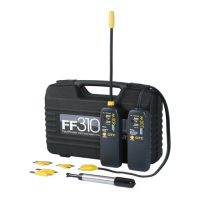Page 8
12.3 Some circuit characteristics that may affect the tracing of a wire:
•
Electromagnetic loop size and geometry, etc. may affect the range of the
FF310R. For example for circuits in which the live and ground (return) wire run
parallel and close to each other in the same circuit, the two magnetic fields
interaction may weaken the signal, thereby reducing the FF310R range.
•
Wires enclosed or tightly lining the metal frame or body of the vehicle, (i.e.: door
frames), have the same effects as having the live and ground wires running in parallel
in the same circuit since, the metal frame or vehicle body will be acting as a ground
wire. Another unfavorable factor may be due to the channeling effect steel parts
have on magnetic fi elds. These two cases, individually or combined, will reduce and
sometimes impede the tracing of the wire sections affected.
Hint: Whenever possible the short circuit mode of operation should be used, because it
provides with the best tracing capabilities.
13 - Special Tracing procedures
•
In all cases, fi rst set the FF310R at the lower sensitivity level and increase it as
necessary. Proceed as indicated in the sections of this User’s Manual applicable
to your situation.
•
Always after locating a probable fault area, verify several points in the wires on both
sides (before and after) the suspected area. The signal should be present at only
one side of the fault (open or short). This procedure will help avoid confusing a signal
loss with the actual trouble point.
13.1 Wire bundles and conduits:
•
Special care should be given in the case of tracing a wire inside a bundle or
conduit when there is a split. In this case it may be possible to follow the wrong branch
for a short distance and still receive a positive audio/visual indication.
•
To avoid following the wrong path, which could happen if the FF310R’s sensor picks
up the signal from the other nearby branch of the circuit, the branches should be swept
maintaining the sensor outside the apex area between the split, as shown in Fig. 8.
•
Careful attention should be paid to the beeping and fl ashing speed of the FF310R
unit indicators, as these provide the necessary feedback to evaluate the proximity
of the sensor to the wire being traced.
Fig. 8 - Tracing Wires inside bundles and conduits
Trace with sensor
on this side
Trace with sensor
on this side
Wire bundle or conduit
Tracing inside this
area may generate
misleading results
13.2 How to increase the pick up range when tracing wires
•
When tracing or identifying wires connected to lightly loaded circuit (low
currents), this reduces the range of pick up signifi cantly. A possible solution is after
connecting the FF310T in series with the circuit to trace, is to replace the load (light
bulb, module, etc.) with a direct connection to ground. This allows the FF310T to
inject a more powerful signal which is easier to detect.
•
For the cases in which it is suspected the layout of the wires is the cause of a very
difficult to pick up or weak signal, a dramatic increase of the range can be
accomplished by “spreading” the circuit.

